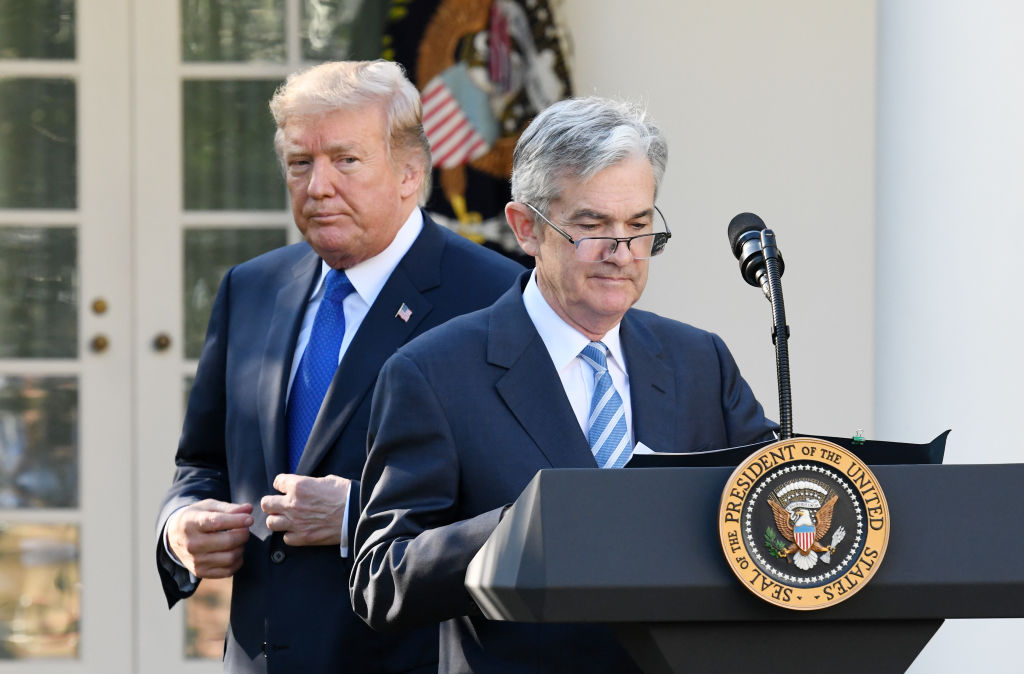Can Trump Fire Powell?
"Can Trump fire Powell?" may not matter anymore as the White House uses its power to get what the president wants from the Fed: lower interest rates.


Though the Supreme Court recently issued an opinion suggesting at least six justices would rule against it, "Can Trump fire Powell?" may be a moot question as the White House explores its power to try to get what the president wants: lower interest rates.
The Office of Management and Budget, for example, has cited cost overruns for the project to renovate facilities in Washington D.C. as evidence of Fed Chair Jerome Powell's broad mismanagement of the central bank.
The leader of the National Economic Council agreed the Federal Reserve is burdened by "a real problem of oversight and excess spending."
From just $107.88 $24.99 for Kiplinger Personal Finance
Become a smarter, better informed investor. Subscribe from just $107.88 $24.99, plus get up to 4 Special Issues

Sign up for Kiplinger’s Free Newsletters
Profit and prosper with the best of expert advice on investing, taxes, retirement, personal finance and more - straight to your e-mail.
Profit and prosper with the best of expert advice - straight to your e-mail.
Treasury Secretary Scott Bessent, meanwhile, said there's no reason for Powell to resign but supports an investigation of the Fed's renovation project as part of a review of whether "the organization has succeeded in its mission."
Indeed, President Donald Trump recently reiterated his criticism of Powell, whom he nominated during his first administration in November 2017 to replace outgoing Fed Chair Janet Yellen.
The president said his man has "done a bad job, but he's going to be out pretty soon anyway. In eight months he'll be out."
President Trump told White House reporters on April 22 that he "never did" intend to fire Powell. "The press runs away with things. No, I have no intention of firing him."
The president didn't stop there, though: "I would like to see him be a little more active in terms of his idea to lower interest rates."
He added, "We think that it's a perfect time to lower the rate, and we would like to see our chairman be early or on time as opposed to late. Late isn't good."
Bessent has been named in discussions of those who will replace Powell as Fed chair.
"Can Trump fire Powell?" might be a bad question anyway
Powell has asked the Fed's inspector general to review the $2.5 billion project.
According to Axios, "The Trump administration is using the Fed's expensive overhaul of two historic buildings on the National Mall as a lever to try to force out Powell, who has rebuffed the president's demands to cut interest rates."
And the juice may not justify the squeeze.
"All this political pressure on the makers of monetary policy could actually backfire on Trump," writes Mizuho Securities Chief U.S. Economist Steven Ricchiuto. "In essence, be careful what you wish for, as you may get it!"
Ricchiuto says "a Fed that simply validates the administration’s fiscal agenda by attempting to keep rates low at both ends of the curve may result in higher rates."
The economist explains that easing the federal funds rate while the economy is growing and with underlying inflation "stuck at 3%, not 2%, will unleash inflation expectations and in the process increase the inflation risk premium."
"Can Trump fire Powell?" is no longer about executive authority
The Supreme Court did not explicitly overrule a 90-year-old precedent in its May 22 opinion, but it did allow President Trump to fire two members of other federal agencies' boards. And it offered a two-sentence summary on the not-yet-ripe can Trump fire Powell? question.
"Finally," the six-member majority wrote in an unsigned opinion, "respondents Gwynne Wilcox and Cathy Harris contend that arguments in this case necessarily implicate the constitutionality of for-cause removal protections for members of the Federal Reserve's Board of Governors or other members of the Federal Open Market Committee.
"We disagree. The Federal Reserve is a uniquely structured, quasi-private entity that follows in the distinct historical tradition of the First and Second Banks of the United States."
In dissent, Associate Justice Elana Kagan wrote that the majority decision results in "the creation of a bespoke Federal Reserve exception."
Investors, traders and speculators are already pricing in their discomfort with the very question and its potential to undermine the independence of the world's most important central bank.
Trump v. Powell
President Trump's April 2 "Liberation Day" tariffs announcement had already generated unprecedented levels of volatility in both stock and bond markets.
In an April 16 appearance at the Economic Club of Chicago, Powell described the uncertainty from a central banker's perspective. "These are very fundamental policy changes," Powell said. "There isn't a modern experience of how to think about this."
Noting that "the level of the tariff increases announced so far is significantly larger than anticipated," Powell explained that the Fed may find itself in a challenging scenario where its dual-mandate goals are in tension.
Because of Trump's policy, "unemployment is likely to go up as the economy slows," and "in all likelihood," inflation is likely to go up as well.
Trump responded the following morning with a post on Truth Social calling for the Fed chair's "termination" and has continued to use his social media platform to disparage Powell.
Meanwhile, a series of articles in The Wall Street Journal and The New York Times have detailed months of conversations between Trump and various White House aides about firing the Fed chair.
Analysts v. Trump
"Trump's renewed attacks on Fed Chairman Jerome Powell raise policy uncertainty but are unlikely to lead to Powell's removal," writes BCA Research macro strategist Felix Vezina-Poirier.
Noting that Powell's term runs through May 2026, Vezina-Poirier says firing him at this point would be "complex, politically risky, and legally lengthy and difficult." Powell also represents a "politically convenient scapegoat" for Trump as sentiment on the economy and markets slide.
"Moreover," the strategist explains, "firing Powell would likely backfire by pushing long-term Treasury yields higher, contradicting the administration's stated preference for lower yields." He adds that "potential replacements … would generally lean toward tighter monetary policy, not the easier stance Trump desires."
Powell's stated priority is to ensure inflation expectations remain well anchored. He feels he has room for patience on the growth side. And there will be no "Powell Put" to save the stock market.
Vezina-Poirier concludes that "Powell's removal would prompt an immediate bear steepening," which means markets would "price in higher term premia and inflation" in the form of higher interest rates.
"Even if the noise regarding Powell were to decline," suggests the forex research team at Barclays, "the dovish pressure on the Fed could persist, which would likely further erode market confidence in the integrity of the greenback."
Related content
Profit and prosper with the best of Kiplinger's advice on investing, taxes, retirement, personal finance and much more. Delivered daily. Enter your email in the box and click Sign Me Up.

David Dittman is the former managing editor and chief investment strategist of Utility Forecaster, which was named one of "10 investment newsletters to read besides Buffett's" in 2015. A graduate of the University of California, San Diego, and the Villanova University School of Law, and a former stockbroker, David has been working in financial media for more than 20 years.
-
 Forget Financial Forecasts: Focus on These 3 Goals for Success
Forget Financial Forecasts: Focus on These 3 Goals for SuccessWe know the economy is unpredictable and markets will do what they do, no matter who predicts what. Here's how to focus on what you can control.
-
 Why In-Person Financial Guidance Remains the Gold Standard
Why In-Person Financial Guidance Remains the Gold StandardFace-to-face conversations between advisers and clients provide the human touch that encourages accountability and a real connection.
-
 How You Can Turn Your Home Equity Into a Retirement Buffer
How You Can Turn Your Home Equity Into a Retirement BufferIf you're one of the many homeowners who has the bulk of your net worth tied up in your home equity, you might consider using that equity as a planning tool.
-
 I'm a Wealth Planner: Forget 2026 Market Forecasts and Focus on These 3 Goals for Financial Success
I'm a Wealth Planner: Forget 2026 Market Forecasts and Focus on These 3 Goals for Financial SuccessWe know the economy is unpredictable and markets will do what they do, no matter who predicts what. Here's how to focus on what you can control.
-
 I'm a Financial Adviser: Why In-Person Financial Guidance Remains the Gold Standard
I'm a Financial Adviser: Why In-Person Financial Guidance Remains the Gold StandardFace-to-face conversations between advisers and clients provide the human touch that encourages accountability and a real connection.
-
 This Is How You Can Turn Your Home Equity Into a Retirement Buffer
This Is How You Can Turn Your Home Equity Into a Retirement BufferIf you're one of the many homeowners who has the bulk of your net worth tied up in your home equity, you might consider using that equity as a planning tool.
-
 Dow Hits New High Then Falls 466 Points: Stock Market Today
Dow Hits New High Then Falls 466 Points: Stock Market TodayThe Nasdaq Composite, with a little help from tech's friends, rises to within 300 points of its own new all-time high.
-
 The Best Vanguard Bond Funds to Buy
The Best Vanguard Bond Funds to BuyInvestors seeking the best Vanguard bond funds can pick between mutual funds and ETFs spanning maturities, credit qualities, tax treatment and geographies.
-
 Feeling Too Guilty to Spend in Retirement? You Really Need to Get Over That
Feeling Too Guilty to Spend in Retirement? You Really Need to Get Over ThatAre you living below your means in retirement because you fear not having enough to leave to your kids? Here's how to get over that.
-
 Strategies for Women to Maximize Social Security Benefits
Strategies for Women to Maximize Social Security BenefitsWomen often are paid less than men and live longer, so it's critical that they know their Social Security options to ensure they claim what they're entitled to.
-
 Dow, S&P 500 Rise to New Closing Highs: Stock Market Today
Dow, S&P 500 Rise to New Closing Highs: Stock Market TodayWill President Donald Trump match his Monroe Doctrine gambit with a new Marshall Plan for Venezuela?